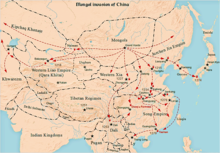
Back الغزو المغولي للصين Arabic Hiina vallutamine mongolite poolt Estonian فتح چین توسط مغولها Persian Invasion mongole en Chine French Mongol hódítás Kelet-Ázsiában Hungarian Penaklukan Tiongkok oleh Mongol ID Conquista mongola della Cina Italian Их Монгол улс болон Юань гүрний үеийн дайн тулаан Mongolian Монгольское завоевание Китая Russian Mongolernas invasion av Kina Swedish
This article needs additional citations for verification. (October 2007) |
| Mongol conquest of China | |||||||||
|---|---|---|---|---|---|---|---|---|---|
| Part of the Mongol invasions and conquests | |||||||||
 Mongol campaigns located in modern-day China. | |||||||||
| |||||||||
| Belligerents | |||||||||
Pre-1234 northern campaigns
| Pre-1234 northern campaigns | ||||||||
Post-1234 southern campaigns
|
Post-1234 southern campaigns
| ||||||||
| Commanders and leaders | |||||||||
| |||||||||

The Mongol conquest of China was a series of major military efforts by the Mongol Empire to conquer various empires ruling over China for 74 years (1205–1279). It spanned seven decades in the 13th century and involved the defeat of the Jin dynasty, Western Liao, Western Xia, Tibet, the Dali Kingdom, the Southern Song, and the Eastern Xia. The Mongol Empire under Genghis Khan started the conquest with small-scale raids into Western Xia in 1205 and 1207.
In 1279, the Mongol ruler Kublai Khan formally established the Yuan dynasty in the Chinese tradition, having crushed the last Song resistance, marking the reunification of China under Mongol rule, the first time that non-Han people had ruled the entire country. It was the first time that Tibet was unified with the rest of China.[1]
- ^ Hugh D. Walker "Traditional Sino-Korean Diplomatic Relations : A Realistic Historical Appraisal", Monumenta Serica, Vol. 24 (1965), pp. 155–16, (p.159)